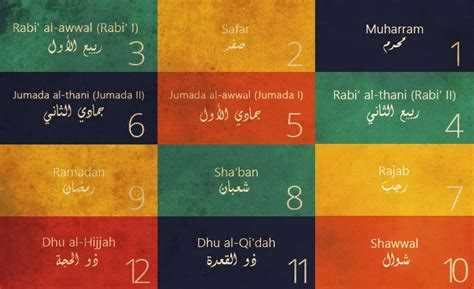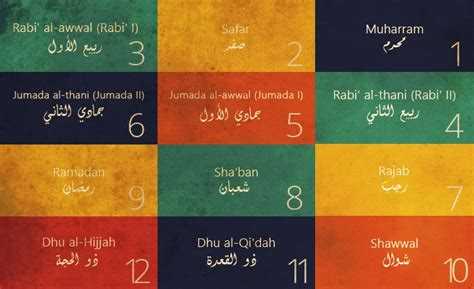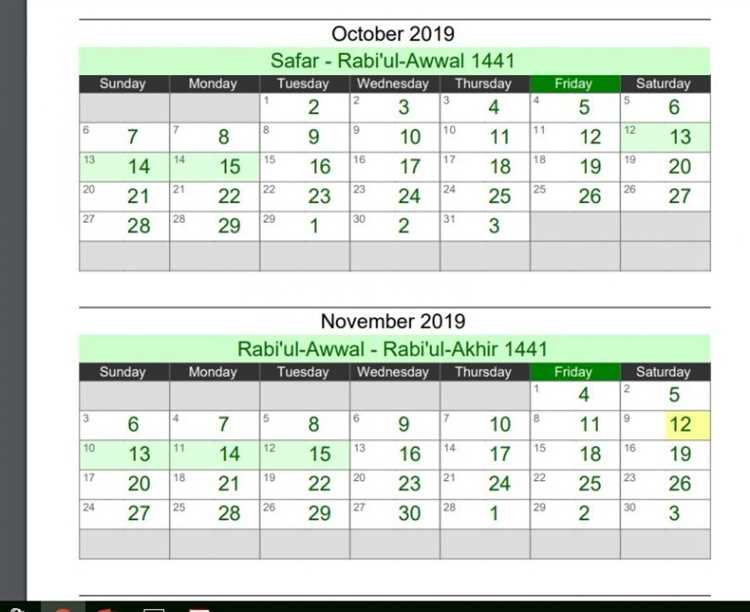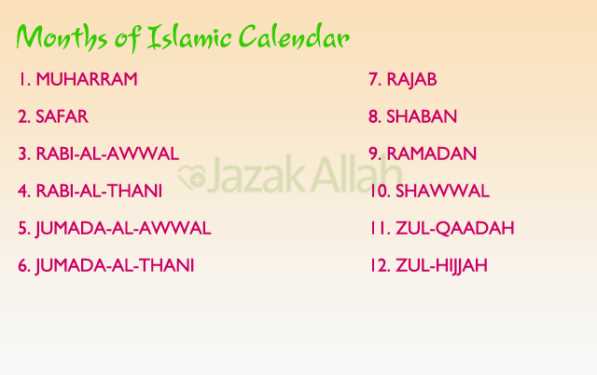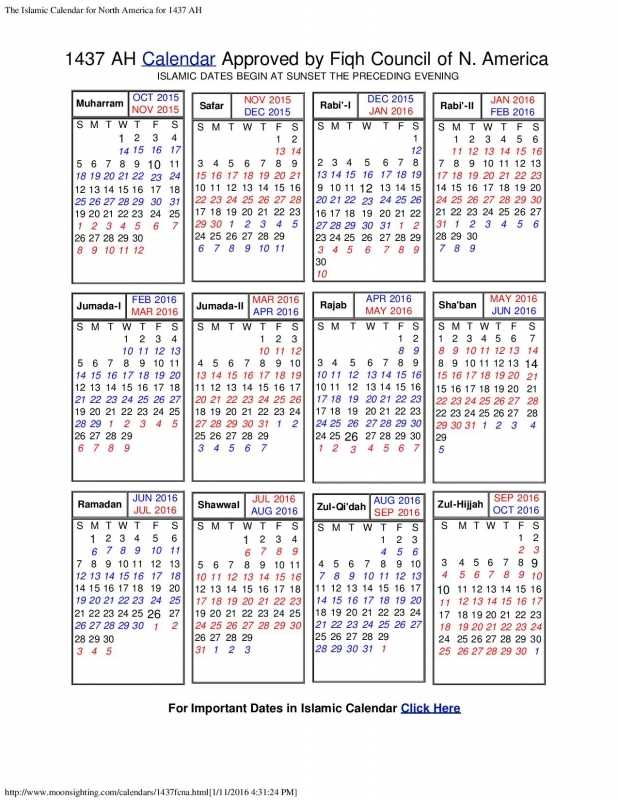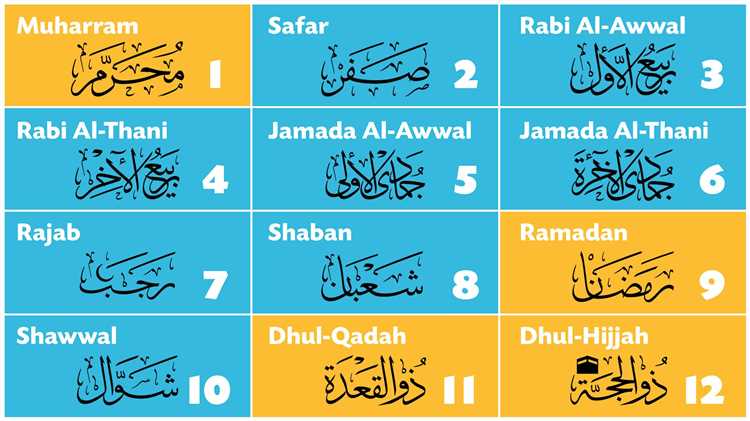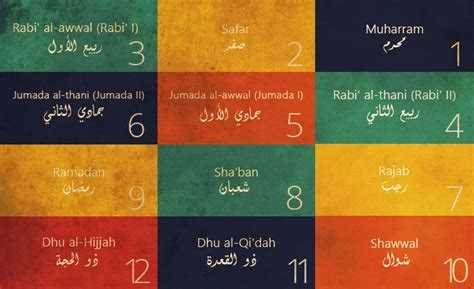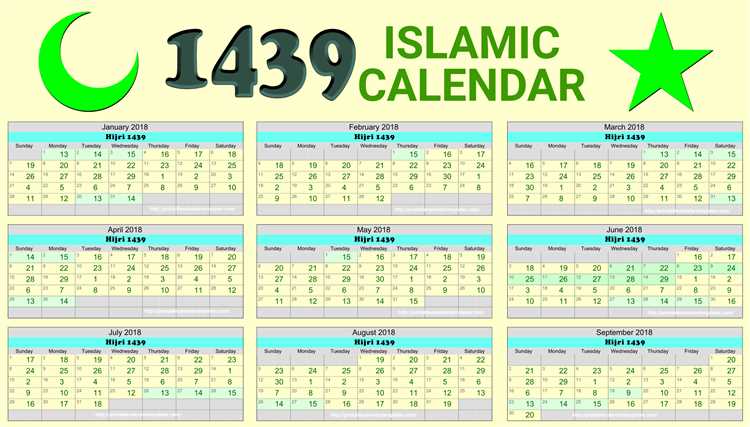The Islamic calendar, also known as the Hijri calendar, is a lunar calendar used by Muslims around the world to determine the dates of religious events and observances. Unlike the Gregorian calendar, which is a solar calendar, the Islamic calendar is based on the cycles of the moon.
The Islamic calendar consists of 12 lunar months, each of which lasts for approximately 29 or 30 days. This means that the Islamic year is about 11 days shorter than the solar year, causing the Islamic months to shift relative to the Gregorian calendar each year. As a result, Islamic holidays and important dates, such as Ramadan and Eid al-Fitr, occur at different times each year.
The beginning of the Islamic calendar is marked by the migration of the Prophet Muhammad (peace be upon him) from Mecca to Medina in the year 622 CE. This event, known as the Hijra, is considered a crucial turning point in Islamic history and is used as the starting point for the Islamic calendar. The Islamic calendar is also based on the sighting of the crescent moon, with the new month beginning when the moon is first observed.
It is important to note that the Islamic calendar is primarily based on lunar observations, rather than astronomical calculations. This means that the dates of Islamic holidays and events can vary depending on the local sighting of the moon. As a result, there can be slight differences in the start and end dates of Islamic months and holidays in different regions and countries. However, efforts are made to ensure that the calendar is standardized and followed globally.
Understanding the Islamic calendar
The Islamic calendar, also known as the Hijri calendar, is a lunar calendar used by Muslims all over the world to determine the dates of religious holidays, fasting periods, and other significant events. Unlike the Gregorian calendar (the standard calendar used in most of the world), the Islamic calendar is based on the phases of the moon.
The Islamic calendar consists of twelve months, each lasting for either 29 or 30 days, depending on the sighting of the moon. This makes the Islamic calendar approximately 10 or 11 days shorter than the Gregorian calendar. As a result, the Islamic calendar does not align with the solar year, causing the dates to shift each year.
The beginning of the Islamic calendar is marked by the migration of the Prophet Muhammad from Mecca to Medina in 622 CE, known as the Hijra. This event is considered significant in Islamic history and serves as the starting point for the Islamic calendar.
Each month starts with the sighting of the new moon, which is typically announced by religious authorities or local mosque committees. This visibility is crucial for determining the start of the new month, and it is often done through visual observation. However, in some cases, astronomical calculations may be used to determine the new month.
The months of the Islamic calendar are as follows:
- Muharram
- Safar
- Rabi’ al-Awwal
- Rabi’ al-Thani
- Jumada al-Awwal
- Jumada al-Thani
- Rajab
- Sha’ban
- Ramadan
- Shawwal
- Dhu al-Qidah
- Dhu al-Hijjah
The most important month in the Islamic calendar is Ramadan, during which Muslims fast from dawn to sunset as a form of worship and reflection. The end of Ramadan is marked by the celebration of Eid al-Fitr, a festive holiday to break the fast.
It is important to note that the Islamic calendar is primarily based on lunar cycles and does not take into account the solar year. As a result, the dates of Islamic holidays and events may vary from year to year in relation to the Gregorian calendar. The sighting of the moon plays a vital role in determining these dates, and regional differences may occur.
In conclusion, the Islamic calendar is a lunar calendar that is used by Muslims worldwide to determine the dates of religious events and holidays. Its unique nature and dependence on moon sightings make it distinct from the Gregorian calendar.
The history of the Islamic calendar
The Islamic calendar, also known as the Hijri calendar, is based on the lunar cycles. It was first introduced in 638 CE by the second caliph of Islam, Umar ibn Al-Khattab.
Before the Islamic calendar was adopted, Muslims used various calendars, including the Julian calendar. However, the lunar-based Islamic calendar was considered more appropriate for religious purposes as it is aligned with the lunar events mentioned in the Quran.
The Islamic calendar consists of 12 lunar months, each lasting for the time it takes for the moon to complete one full cycle, which is approximately 29.5 days. As a result, the Islamic year is shorter than the Gregorian year by around 11 days.
In order to account for this difference, the Islamic calendar uses a 30-year cycle known as the Meccan lunar cycle. This cycle divides the years into two categories: 19 normal years and 11 leap years. Leap years have an extra month inserted to keep the calendar in line with the solar year.
The Islamic calendar is not fixed to the seasons, so the dates of Islamic holidays and events differ each year when compared to the Gregorian calendar. To determine the start of each month, the sighting of the new moon is observed. If the new moon is not visible due to weather conditions, the previous month is extended to 30 days.
The Islamic calendar has been in use for over 1,400 years and continues to be used by Muslims worldwide. It is an important religious and cultural aspect of the Islamic faith, helping Muslims organize their religious duties and celebrations.
The lunar-based system
The Islamic calendar is a lunar-based system, meaning it follows the phases of the moon. Unlike the Gregorian calendar, which is based on the solar year, the Islamic calendar consists of twelve lunar months, each lasting approximately 29 or 30 days.
Due to the shorter length of a lunar month, the Islamic calendar is approximately 11 days shorter than the solar-based Gregorian calendar. As a result, the Islamic calendar shifts forward about 11 days each year compared to the Gregorian calendar.
The start of each month in the Islamic calendar is determined by the sighting of the new crescent moon. A group of qualified individuals, known as moon-sighting committees, are responsible for observing the moon and declaring the start of each month. These committees rely on visual sightings of the new moon, and their decisions may vary based on regional differences and local customs.
Due to the reliance on moon sightings, the Islamic calendar is more of an observational calendar, and its dates may be subject to minor variations. This can lead to differences in the start and end dates of Islamic months, especially in different parts of the world.
One important difference between the Gregorian calendar and the Islamic calendar is that the Islamic calendar does not have leap years. Instead, the lunar year is approximately 354 or 355 days long, which means it is about 10 or 11 days shorter than the solar year. To align the lunar year with the solar year, the Islamic calendar compensates for this discrepancy by adding an extra month in certain years. This month is known as “Muharram al-Haram” (the sacred Muharram) and is inserted after the twelfth month of the lunar year.
Months in the Islamic calendar
The Islamic calendar, also known as the Hijri calendar, is a lunar calendar that is used by Muslims all over the world to determine the dates of religious events and observances. It is based on the moon’s cycle and has a total of 12 months.
Here are the 12 months in the Islamic calendar:
- Muharram
- Safar
- Rabi’ al-Awwal
- Rabi’ al-Thani
- Jumada al-Awwal
- Jumada al-Thani
- Rajab
- Sha’ban
- Ramadan
- Shawwal
- Dhu al-Qidah
- Dhu al-Hijjah
Each month in the Islamic calendar is either 29 or 30 days long, depending on the sighting of the crescent moon. The calendar is not synchronized with the solar year, which means that the dates of Islamic holidays shift each year in relation to the Gregorian calendar.
The first month of the Islamic calendar is Muharram, which is considered a sacred month. It is followed by Safar, and then the two months of Rabi’ al-Awwal and Rabi’ al-Thani. The next two months are Jumada al-Awwal and Jumada al-Thani.
The seventh month is Rajab, which is known as a month of peace and tranquility. It is followed by Sha’ban, and then the holy month of Ramadan, during which Muslims fast from sunrise to sunset. Shawwal is the month after Ramadan, and it is followed by Dhu al-Qidah, which is a sacred month.
The twelfth and final month of the Islamic calendar is Dhu al-Hijjah. This month is significant because it is during this time that the annual pilgrimage to Mecca, known as Hajj, takes place.
Overall, the months in the Islamic calendar have great importance in the lives of Muslims and play a crucial role in determining the timing of religious events and practices.
The significance of Ramadan
Ramadan is the ninth month of the Islamic calendar and holds great significance for Muslims around the world. It is considered as the holiest month in Islam and is observed by Muslims as a time of fasting, prayer, reflection, and community.
The primary purpose of Ramadan is to attain taqwa, which is a state of spiritual purity and consciousness of God. Fasting during this month is a major pillar of Islam and is obligatory for all adult Muslims, with the exception of those who are ill, pregnant, breastfeeding, traveling, or menstruating.
Fasting in Ramadan involves abstaining from food and drink from dawn until sunset. However, it is not just about refraining from eating and drinking; it also includes abstaining from any immoral or sinful behavior and striving to become a better person.
During the fast, Muslims are encouraged to read the Qur’an, engage in prayer and supplication, provide charity to the less fortunate, and spend time with family and friends. The month of Ramadan is seen as a time of spiritual reflection and increased devotion to God.
Another significant aspect of Ramadan is the Night of Power or Laylat al-Qadr. It is believed to be a night that is better than a thousand months and is considered the holiest night of the year. Muslims spend this night in prayer, seeking forgiveness, and engaging in acts of worship.
Ramadan is also a time for increased family and community gatherings. Muslims come together for iftar, the meal that breaks the fast at sunset, and suhoor, the pre-dawn meal before fasting begins. These meals are often shared with family, friends, and neighbors, fostering a sense of unity and fellowship within the community.
Overall, Ramadan holds great significance in the lives of Muslims. It serves as a time of physical and spiritual cleansing, self-discipline, and increased devotion to God. Through fasting and engaging in acts of worship, Muslims seek to strengthen their relationship with God and foster a sense of empathy and compassion towards others.
| Month | Ramadan |
| Significance | Holiest month in Islam, fasting, prayer, reflection, and community |
| Primary purpose | Attaining taqwa (spiritual purity and consciousness of God) |
| Fasting | Abstaining from food, drink, and sinful behavior from dawn until sunset |
| Night of Power | Laylat al-Qadr, holiest night of the year |
| Community | Family and community gatherings for iftar and suhoor |
Observing Eid al-Fitr
Eid al-Fitr, also known as the “Festival of Breaking the Fast,” is one of the most important religious holidays in Islam. It marks the end of Ramadan, the month of fasting, and is a joyous occasion for Muslims around the world.
Fasting during Ramadan:
During the holy month of Ramadan, Muslims fast from dawn to sunset, abstaining from food, drink, smoking, and other physical needs. Fasting is seen as a way to purify the soul and focus on spiritual growth.
Eid prayer:
On the day of Eid al-Fitr, Muslims gather in mosques or open spaces for a special prayer called the Eid prayer. This prayer is performed in congregation and is led by an Imam. It is a time for the community to come together and celebrate the completion of Ramadan.
Charitable giving:
Charitable giving, known as Zakat al-Fitr, is an essential part of Eid al-Fitr. Muslims are obligated to give a certain amount of money or food to those in need before the Eid prayer. This act of charity ensures that everyone in the community can partake in the joy of Eid.
Feasting and celebrations:
After the Eid prayer, Muslims typically gather with family and friends to enjoy a festive meal. Special dishes are prepared, and it is a time for loved ones to connect and celebrate together. Gifts are often exchanged, and children receive special treats and presents.
Visiting loved ones:
During Eid al-Fitr, it is customary to visit family, friends, and neighbors to strengthen relationships and spread joy. This tradition allows Muslims to express gratitude for the blessings of Ramadan and to connect with their community.
Eid al-Fitr in the Islamic calendar:
Eid al-Fitr falls on the first day of the month of Shawwal, which follows Ramadan in the Islamic calendar. However, the exact date of Eid can vary from country to country, depending on the sighting of the new moon.
Conclusion:
Eid al-Fitr is a time of gratitude, celebration, and giving for Muslims around the world. It is an opportunity to strengthen ties with loved ones and to reflect on the spiritual growth achieved during Ramadan. Through fasting, prayer, and acts of charity, Muslims observe and honor this important holiday in the Islamic calendar.
The Importance of Hajj
Hajj is one of the five pillars of Islam and is considered the most important pilgrimage for Muslims around the world. It is an obligation for every able-bodied and financially capable Muslim to perform Hajj at least once in their lifetime.
Hajj holds great significance in the lives of Muslims for various reasons:
- Spiritual Cleansing: Hajj is believed to be a journey of spiritual cleansing and purification. It allows Muslims to seek forgiveness for their sins, repent, and start afresh. The act of completing the rituals of Hajj is believed to bring one closer to God and attain spiritual elevation.
- Unity and Equality: During Hajj, millions of Muslims from different countries, races, and backgrounds gather together in Mecca. It is a time for Muslims to feel a sense of unity and equality, as all pilgrims are required to dress in simple white garments, removing any distinction of social or economic status. This experience reinforces the Islamic belief in the equality of all believers.
- Following the Footsteps of Prophets: Hajj retraces the footsteps of Prophets Ibrahim (Abraham), Ismail (Ishmael), and Muhammad (peace be upon them). Muslims believe that these prophets, through their obedience to God’s commands, set the ultimate example of faith and surrender. By performing the same rituals as these revered figures, Muslims feel a deeper connection with their faith and history.
- Community and Brotherhood: Hajj provides an opportunity for Muslims from different corners of the world to come together as a global community. It allows for the strengthening of bonds, the exchange of ideas, and the fostering of brotherhood. Muslims can learn from each other’s cultures and experiences, ultimately promoting a sense of unity and understanding.
- Submission to God’s Will: The rituals of Hajj require a high level of dedication, patience, and sacrifice. By willingly participating in these rituals, Muslims demonstrate their submission and surrender to the will of God. Hajj teaches the importance of self-discipline and the ability to let go of worldly desires in order to prioritize spiritual growth.
Overall, Hajj is a transformative experience for Muslims. It is a time of self-reflection, devotion, and growth, allowing individuals to strengthen their faith and renew their commitment to Islam. The importance of Hajj goes beyond the physical journey; it is a spiritual and communal act that encompasses the core values of Islam.
Islamic Holidays and Celebrations
Islamic calendar is filled with various holidays and celebrations that hold significant importance in the Muslim community. These events are based on religious observations and historical events in Islam. Here are some of the major Islamic holidays and celebrations:
- Eid al-Fitr: This is the festival of breaking the fast, which marks the end of Ramadan. It is a joyous celebration where Muslims gather for prayers, share meals, and exchange gifts.
- Eid al-Adha: Also known as the Festival of Sacrifice, it commemorates the willingness of Ibrahim (Abraham) to sacrifice his son as an act of obedience to God’s command. Muslims around the world perform animal sacrifices and distribute meat to the less fortunate.
- Milad un Nabi: This is the observance of the birth of Prophet Muhammad. Muslims celebrate his life and teachings and engage in special prayers, gatherings, and lectures.
- Laylat al-Qadr: It is considered the most significant night of the year, often referred to as the Night of Power. Muslims engage in intense prayers and worship, seeking forgiveness and blessings.
- Ashura: This day marks historical events such as the rescue of Prophet Moses (Musa) from Pharaoh and the martyrdom of Imam Husayn, the grandson of Prophet Muhammad, in the Battle of Karbala. It is observed as a day of fasting and mourning.
In addition to these major holidays, Muslims also observe various other celebrations such as the Islamic New Year (Hijri New Year), the Night Journey (Isra and Mi’raj), and the Prophet’s Night Journey (Shab-e-Meraj), among others. These events hold great spiritual and cultural significance for Muslims worldwide.
It is important to note that the dates of Islamic holidays are determined by the lunar calendar, which differs from the Gregorian calendar commonly used in the Western world. Therefore, the dates of these holidays vary each year and may differ by region.
| Holiday | Date |
|---|---|
| Eid al-Fitr | 1st day of Shawwal |
| Eid al-Adha | 10th day of Dhu al-Hijjah |
| Milad un Nabi | 12th day of Rabi’ al-Awwal |
| Laylat al-Qadr | Last 10 days of Ramadan |
| Ashura | 10th day of Muharram |
These holidays and celebrations play a vital role in the lives of Muslims, fostering a sense of unity, spirituality, and remembrance of their faith and history.
Islamic calendar and the solar year
The Islamic calendar, also known as the Hijri calendar, is a lunar calendar based on the phases of the moon. Unlike the solar calendar, which is based on the Earth’s movement around the sun, the Islamic calendar has a shorter year and does not align with the seasons. This means that Islamic holidays and events occur at different times each year according to the Gregorian calendar, which is based on the solar year.
The Islamic calendar consists of 12 lunar months, each lasting either 29 or 30 days, depending on the sighting of the new moon. This makes the Islamic year approximately 11 days shorter than the solar year. As a result, the Islamic calendar rotates through all four seasons over a period of about 33 years.
To accommodate for the difference between the lunar and solar calendars, an additional month called “Adh-dhi’Hijjah” is added to the Islamic calendar in certain years. This is known as a “leap year” in the Islamic calendar and helps to keep the lunar months in line with the solar year.
While the Islamic calendar is primarily used to determine the dates of Islamic holidays and observances, it is also used for religious purposes such as determining the times for daily prayers and starting and ending the fasting month of Ramadan.
It is important to note that the Islamic calendar is not universally followed in all Muslim-majority countries, as some countries also use the Gregorian calendar for official purposes. However, the Islamic calendar remains widely used and is of significant importance in determining the dates of religious events for Muslims worldwide.
Calculating the Islamic date
The Islamic calendar, also known as Hijri calendar, is a lunar calendar which is based on the cycles of the moon. The calendar consists of 12 lunar months, each made up of either 29 or 30 days, resulting in a total of about 354 or 355 days in a year. As the lunar months are shorter than the solar months, the Islamic calendar shifts about 11 days earlier each year with respect to the Gregorian calendar.
To calculate the Islamic date, several factors need to be taken into consideration:
- Observing the new moon: The start of a new month in the Islamic calendar is determined by sighting the new moon. Traditionally, Muslim authorities would search for the first crescent of the new moon each month. Nowadays, many Islamic organizations rely on astronomical calculations to determine the moon’s visibility.
- The Islamic lunar calendar: The Islamic calendar follows a 30-year cycle that alternates between 19 years of 354 days and 11 years of 355 days. This cycle is known as the Metonic cycle, and it ensures that the lunar months align with the solar year over time.
- Adjustments for the lunar calendar: The lunar calendar occasionally requires adjustments to stay synchronized with the solar year. The most common method is the addition of an extra day to the last month of the year, known as the intercalation of the leap year.
When calculating the Islamic date, it’s important to refer to reliable Islamic calendars which are prepared by reputable Islamic organizations. These calendars provide accurate dates for the start of each Islamic month, as well as other significant dates within the Islamic year.
It’s worth noting that due to differences in moon sightings and interpretation, there may be slight variations in the determination of the Islamic date among different regions or communities. However, the variances are usually minimal and do not impact the overall observance of Islamic holidays and religious practices.
In conclusion, calculating the Islamic date involves considerations such as the sighting of the new moon, the lunar calendar cycle, and occasional adjustments to keep it in line with the solar year. By relying on accurate Islamic calendars, individuals can stay aware of the Islamic date and observe important religious events and practices accordingly.
The role of the lunar sighting
In the Islamic calendar, the lunar sighting plays a vital role in determining the beginning and end of each month. Muslims rely on the actual sighting of the new moon to mark the start of a new month. This method is in accordance with the teachings of the Quran and the traditions of Prophet Muhammad.
Unlike the Gregorian calendar, which follows a fixed pattern, the Islamic calendar is dependent on the sighting of the crescent moon. This means that the length of each month can vary from 29 to 30 days. Since the lunar cycle is approximately 29.5 days, it is necessary to observe the moon to accurately determine the start of a new month.
The lunar sighting is a community effort, with designated individuals known as “moon-sighting committees” responsible for looking for the new moon. These committees consist of knowledgeable individuals who are trained to observe the sky and identify the presence of the new crescent moon. They use specialized equipment such as telescopes and binoculars to assist them in their observations.
Once the new moon is sighted and verified, the religious authorities announce the beginning of the new month. This announcement is usually made through local mosques and religious organizations. Muslims around the world then adjust their calendars and schedules according to this announcement.
The reliance on the lunar sighting adds a level of uncertainty to the Islamic calendar, as the visibility of the new moon can be affected by various factors such as weather conditions and geographic location. As a result, there can be slight variations in the start and end dates of Islamic months in different regions.
Despite the challenges posed by relying on the lunar sighting, it is considered an important aspect of the Islamic calendar. It serves as a reminder of the dependence on nature and the constant changes in the world. It also fosters a sense of community as Muslims come together to observe and verify the sighting of the new moon.
In conclusion, the lunar sighting plays a crucial role in the functioning of the Islamic calendar. It helps determine the start and end of each month, and its reliance on the actual sighting of the new moon adds a unique aspect to the Islamic calendar system.
Adjustments and leap years in the Islamic calendar
The Islamic calendar is a lunar calendar, meaning it is based on the cycles of the moon. As a result, adjustments need to be made in order to keep the calendar aligned with the solar year. These adjustments are necessary because the length of a lunar year is approximately 11 days shorter than a solar year.
One of the main adjustments made in the Islamic calendar is the addition of leap years, known as “intercalation”. In the Islamic calendar, a leap year occurs every two to three years. The decision to add a leap year is based on the sighting of the new crescent moon. If the new crescent moon is not visible on the 29th day of a lunar month, then that month is extended to 30 days and the following month is considered the first day of the new lunar month.
Another adjustment made in the Islamic calendar is the synchronization with the Gregorian calendar. The Gregorian calendar is a solar calendar used by most of the world today. In order to synchronize the Islamic calendar with the Gregorian calendar, a specific algorithm is used to determine the start of the Islamic year, which is based on the sighting and calculations of the new moon.
The Islamic calendar also has a fixed reference point for the start of the calendar, known as the Hijri era. The Hijri era begins with the migration of Prophet Muhammad from Mecca to Medina in 622 CE. This event, known as the Hijra, marks the start of the Islamic calendar and is considered a significant historical event for Muslims.
In summary, the Islamic calendar incorporates adjustments such as leap years and synchronization with the Gregorian calendar to ensure it remains aligned with the solar year. These adjustments are made based on the sighting of the new crescent moon and the calculation of the lunar and solar cycles. The calendar also has a fixed reference point in the Hijri era, which marks the migration of Prophet Muhammad and the beginning of the Islamic calendar.
Variations in the Islamic calendar
The Islamic calendar, also known as the Hijri calendar, is based on the moon sighting and the lunar cycles. While the basic structure of the Islamic calendar remains consistent, there are some variations and differences in its usage and interpretation among different Muslim communities around the world.
1. Moon Sighting Method:
One of the major variations in the Islamic calendar is the method of moon sighting. Some communities rely on local moon sightings to determine the start and end of each month, while others follow global moon sighting or astronomical calculations. These differences can lead to variations in the starting date of Islamic months and significant events.
2. Regional Differences:
The Islamic calendar is followed by Muslim communities worldwide, and there can be variations in certain regional practices and traditions. For example, some countries may observe different holidays or celebrate them on different dates based on their cultural and historical significance.
3. Calculation Methods:
There are different calculation methods used to determine the lunar month in the Islamic calendar. The most widely used methods are the Umm al-Qura calendar, based on calculations done in Saudi Arabia, and the Makkah calendar, which is used in other parts of the Muslim world. These methods can result in slight differences in the dates of Islamic months.
4. Leap Years:
The Islamic calendar is based on a 12-month lunar year of 354 or 355 days. To align the lunar year with the solar year, which is approximately 365 days, the Islamic calendar includes leap years. However, there are different opinions on when the leap year should occur, leading to variations in determining this additional month.
5. Cultural Practices:
Islamic calendar-related practices can also vary due to cultural customs and traditions followed by different Muslim communities. For example, certain regions may have specific ways of observing Ramadan or celebrating Eid al-Fitr that differ from one another.
In conclusion, while the Islamic calendar serves as a common timekeeping system for Muslims around the world, there are variations in its implementation and interpretation. These variations are a result of different moon sighting methods, regional differences, calculation methods, leap year determination, and cultural practices.
The role of the Islamic calendar in daily life
The Islamic calendar, also known as the Hijri calendar, plays a significant role in the daily lives of Muslims around the world. It not only serves as a tool to mark the passage of time but also guides religious activities, cultural events, and social gatherings.
1. Religious Observances:
The Islamic calendar determines the timing of important religious observances, such as the start and end of Ramadan, the month of fasting, and the celebration of Eid al-Fitr, which marks the end of Ramadan. It also determines the dates for Hajj, the annual pilgrimage to Mecca.
2. Daily Prayers:
The Islamic calendar plays a crucial role in determining the daily prayer times for Muslims. The five daily prayers, known as Salah, are performed at specific times throughout the day, which are determined based on the position of the sun. The Islamic calendar helps in accurately calculating the prayer times based on the lunar cycle.
3. Cultural Events:
The Islamic calendar is also associated with various cultural events and celebrations. For example, the Islamic New Year, known as Muharram, marks the beginning of the Islamic calendar and is observed with prayers, reflection, and fasting. Other cultural events like Eid al-Adha, the Festival of Sacrifice, and the Prophet Muhammad’s birthday are also celebrated based on the Islamic calendar.
4. Social Gatherings:
The Islamic calendar plays a role in organizing social gatherings and events within the Muslim community. It helps in planning weddings, birthdays, and other important milestones, ensuring that these events do not conflict with significant religious dates and observances.
5. Personal Planning:
Individuals also use the Islamic calendar for personal planning and organizing their daily lives. It helps in scheduling appointments, meetings, and other daily activities while taking into account the religious obligations and cultural events associated with specific dates.
6. Historical and Cultural Significance:
The Islamic calendar has historical and cultural significance beyond its practical uses. It is a symbol of the rich Islamic heritage and provides a sense of identity and belonging to Muslims worldwide. It serves as a reminder of the events and achievements of the Islamic empire and the contributions of Islamic scholars and thinkers throughout history.
In conclusion, the Islamic calendar is an essential tool that not only helps in religious observances but also influences the cultural, social, and personal aspects of Muslims’ daily lives. It serves as a guide for planning religious activities, cultural events, personal appointments, and commemorating historical and cultural milestones.
The influence of the Islamic calendar on Islamic culture
The Islamic calendar, also known as the Hijri calendar, has a significant influence on Islamic culture. It serves as a guide for Muslims in determining the religious observances and events that shape their lives.
Dating System:
The Islamic calendar follows a lunar-based system, which is different from the standard Gregorian calendar. It consists of 12 lunar months, with each month beginning and ending with the sighting of the new moon. This system has a direct impact on various aspects of Islamic culture, including religious festivals and daily practices.
Religious Festivals:
The Islamic calendar determines the dates for important religious festivals, such as Ramadan and Eid al-Fitr. Ramadan, the month of fasting, is observed by Muslims worldwide. It is a time of self-reflection, prayer, and abstinence from food and drink from sunrise to sunset. Eid al-Fitr marks the end of Ramadan and is celebrated with feasts, family gatherings, and acts of charity.
Pilgrimage to Mecca:
Another significant aspect of Islamic culture influenced by the Islamic calendar is the Hajj pilgrimage to Mecca. The Hajj is one of the Five Pillars of Islam and is obligatory for all Muslims who are physically and financially capable. It takes place during the month of Dhul Hijjah, the last month of the Islamic calendar. The precise timing of the Hajj is determined by the lunar-based calendar.
Islamic New Year:
The Islamic calendar also marks the beginning of the Islamic New Year. It is a time for Muslims to reflect on the past year and set intentions for the upcoming year. The first day of the Islamic year, known as Muharram, holds religious significance and is observed with prayers and contemplation.
Daily Practices:
The Islamic calendar influences daily practices and routines for Muslims. The timings of prayers, such as Fajr (dawn) and Maghrib (sunset), are determined by the lunar-based calendar. Additionally, the Islamic calendar is used to calculate the times for fasting during Ramadan, as well as for determining the days on which certain acts of worship are recommended or discouraged.
Overall Impact:
The Islamic calendar plays a crucial role in shaping Islamic culture and practices. It provides a framework for religious observances, festivals, and rituals, and serves as a unifying factor for Muslims worldwide. Additionally, it fosters a sense of community and connection among Muslims as they come together to celebrate and observe important events in the Islamic calendar.
Relevance of the Islamic calendar in the modern world
The Islamic calendar, also known as the Hijri calendar, is of great relevance in the modern world for Muslims worldwide. It not only helps them keep track of important religious events and holidays, but it also serves as a reminder of their faith and its teachings. Here are some reasons why the Islamic calendar holds relevance in today’s society:
- Cultural and religious significance: The Islamic calendar is deeply rooted in Islamic culture and holds immense religious significance for Muslims. It marks the start of the Islamic era, which began with the migration of Prophet Muhammad from Mecca to Medina. By following this calendar, Muslims can preserve their cultural identity and maintain a strong connection to their religion.
- Observance of Islamic holidays and events: The Islamic calendar is based on the lunar cycle, and as a result, the dates of important Islamic holidays and events, such as Ramadan (the month of fasting) and Eid al-Fitr (the festival that marks the end of Ramadan), change each year. By using the Islamic calendar, Muslims can accurately determine the timings of these occasions and observe them in accordance with their faith.
- Community cohesion: The Islamic calendar plays a crucial role in fostering a sense of community and unity among Muslims. When Muslims worldwide observe important religious events based on the same calendar, it promotes a sense of togetherness and allows them to feel connected to each other regardless of geographical boundaries.
- Planning and organization: A standardized calendar is essential for planning and organizing various aspects of life. By using the Islamic calendar, Muslims can plan their daily activities, work schedules, and family events while also taking into account the timings of important religious events. This helps ensure that their religious obligations are met without any conflicts.
Overall, the Islamic calendar continues to hold relevance in the modern world by providing a framework for Muslims to practice their faith, observe important religious events, and foster a sense of unity within the Muslim community. Its cultural and religious significance, along with its role in planning and organizing, make it an integral part of the lives of Muslims worldwide.
FAQ
What is the Islamic calendar?
The Islamic calendar, also known as the Hijri calendar, is a lunar calendar used by Muslims to determine the dates of Islamic holidays and religious events.
How does the Islamic calendar work?
The Islamic calendar is based on the sighting of the moon. It consists of 12 lunar months, with each month beginning and ending with the sighting of the new moon. The length of each month can vary between 29 and 30 days depending on the appearance of the moon. This is in contrast to the Gregorian calendar, which is a solar calendar.
What is the significance of the Islamic calendar?
The Islamic calendar is of great significance to Muslims as it determines the timing of religious ceremonies and observances, such as Ramadan, Hajj, and Eid al-Fitr. It also provides a means for Muslims to track the passage of time according to Islamic traditions.
How is the Islamic calendar different from the Gregorian calendar?
The Islamic calendar is a lunar calendar, while the Gregorian calendar is a solar calendar. This means that the Islamic calendar is shorter by approximately 10-12 days than the Gregorian calendar. Additionally, the Islamic calendar does not have leap years, so it does not align with the seasons and has a different system for determining the start of a new month.
